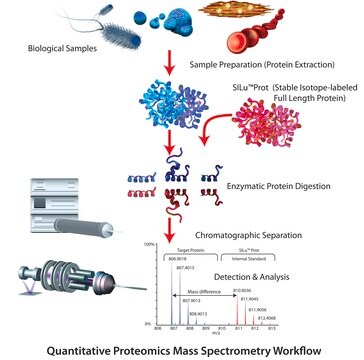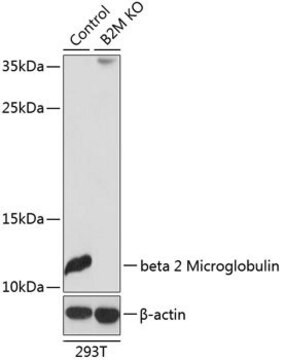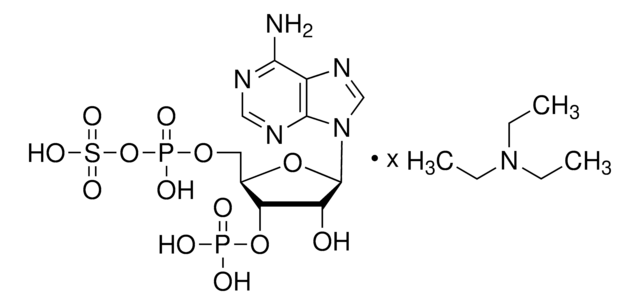M7398
Monoclonal Anti-β2-Microglobulin antibody produced in mouse
clone BM-63, ascites fluid
Sign Into View Organizational & Contract Pricing
All Photos(1)
About This Item
Recommended Products
biological source
mouse
Quality Level
conjugate
unconjugated
antibody form
ascites fluid
antibody product type
primary antibodies
clone
BM-63, monoclonal
mol wt
antigen 12 kDa
contains
15 mM sodium azide
species reactivity
human
technique(s)
indirect ELISA: 1:1000
indirect immunofluorescence: 1:500 using human PBL′s
isotype
IgG1
UniProt accession no.
shipped in
dry ice
storage temp.
−20°C
target post-translational modification
unmodified
Gene Information
human ... B2M(567)
General description
β-2-microglobulin is part of the human leukocyte antigen, where it represents the light chain. It is expressed on cell membranes and is made up of 99 amino acids. β-2-microglobulin is part of the immunoglobulin superfamily. β−2-Microglobulin is a membrane glycoprotein of mammalian nucleated cells including lymphocytes.
Monoclonal anti-β-2-Microglobulin (mouse IgG1 isotype) is derived from the hybridoma produced by the fusion of mouse myeloma cells and splenocytes from an immunized mouse.
Immunogen
human β2-microglobulin and a lysate of a lymphoblastoid cell line.
Application
Monoclonal Anti-β2-Microglobulin antibody produced in mouse has been used in ELISA and immunofluorescent labelling.
Biochem/physiol Actions
β-2-microglobulin acts as a tumor marker and has been shown to be associated with dialysis-related amyloidosis. It may function as a structural part of the MHC Class I molecule.
Microglobulin may be elevated in the serum or urine of patients with systemic lupus erythematosus (SLE), rheumatoid arthritis, metal toxications, some viral infections and possibly malignant disorders and AIDS.
Disclaimer
Unless otherwise stated in our catalog or other company documentation accompanying the product(s), our products are intended for research use only and are not to be used for any other purpose, which includes but is not limited to, unauthorized commercial uses, in vitro diagnostic uses, ex vivo or in vivo therapeutic uses or any type of consumption or application to humans or animals.
Not finding the right product?
Try our Product Selector Tool.
Storage Class Code
10 - Combustible liquids
WGK
nwg
Flash Point(F)
Not applicable
Flash Point(C)
Not applicable
Choose from one of the most recent versions:
Already Own This Product?
Find documentation for the products that you have recently purchased in the Document Library.
The production, purification and crystallization of a soluble form of the nonclassical MHC HLA-G: the essential role of cobalt
Clements CS, et al.
Acta Crystallographica Section F, Structural Biology and Crystallization Communications, 62(1), 70-73 (2006)
Serum Beta 2-microglobulin/cystatin C index: a useful biomarker in lupus nephritis
Silva MVM, et al.
Nephron extra, 2(1), 169-176 (2012)
Alon Margalit et al.
Journal of immunology (Baltimore, Md. : 1950), 176(1), 217-224 (2005-12-21)
Level and persistence of antigenic peptides presented by APCs on MHC class I (MHC-I) molecules influence the magnitude and quality of the ensuing CTL response. We recently demonstrated the unique immunological properties conferred on APCs by expressing beta2-microglobulin (beta2m) as
A role for calnexin in the assembly of the MHC class I loading complex in the endoplasmic reticulum.
G Diedrich et al.
Journal of immunology (Baltimore, Md. : 1950), 166(3), 1703-1709 (2001-02-13)
Heterodimers of MHC class I glycoprotein and beta(2)-microglobulin (beta(2)m) bind short peptides in the endoplasmic reticulum (ER). Before peptide binding these molecules form part of a multisubunit loading complex that also contains the two subunits of the TAP, the transmembrane
Craig S Clements et al.
Acta crystallographica. Section F, Structural biology and crystallization communications, 62(Pt 1), 70-73 (2006-03-03)
HLA-G is a nonclassical class I major histocompatibility complex (MHC) molecule that is primarily expressed at the foetal-maternal interface. Although the role of HLA-G has not been fully elucidated, current evidence suggests it protects the foetus from the maternal immune
Our team of scientists has experience in all areas of research including Life Science, Material Science, Chemical Synthesis, Chromatography, Analytical and many others.
Contact Technical Service








